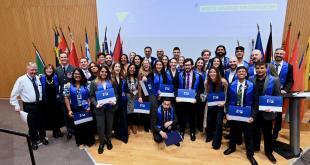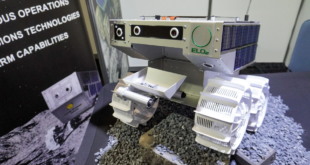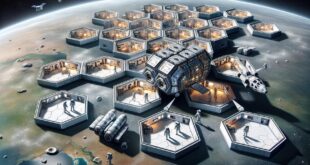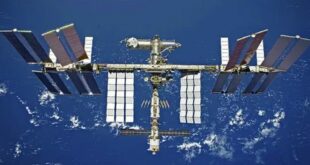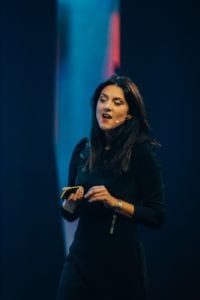
Barbara Belvisi is the CEO and founder of Interstellar Lab, a company that builds space-inspired villages here on Earth. Before starting such an unusual venture, she worked as an investor and co-founded a few STEM initiatives in Europe – namely Hello Tomorrow and Hardware Club. She then became the youngest female founder of a Paris-based venture capital firm, focused on robotics and hardware. Belvisi was also included in the Top 10 Women in Tech In France (2018) and the Global Top 100 of Forbes. SpaceWatch.Global’s contributing editor Valerie Vlasenko sat down with Barbara to talk about her latest venture and how it is going to inspire space exploration.
What exactly does the Interstellar Lab do? What do you plan to achieve with it?
We are using space technology to design a station where people will learn how to live sustainably on this planet before we eventually go to Mars.
While working on the Hardware Club I started noticing that many hardware companies didn’t take into account sustainability and environmental issues. So when I left, I was really looking for ideas that would help us live more sustainably. I have been very passionate about space since I was a kid so I was trying to find a way to combine those two fields – sustainability and space. This is how the idea of Interstellar Lab came about.
We are building a village, where people can go on a holiday and try to live like astronauts for a couple of days. The village will be open to the general public and will introduce them to space science and experiments. As a visitor, you can wear space suits, participate in science experiments, and have a chat with astronauts on the spot. You may stay for a week or two or longer, depending on how many missions you want to be a part of. You will be in the shoes of those first explorers and you will learn how to live in a more sustainable way generating little to no waste and reusing daily life products.
Very cool! So basically you want to invite more space enthusiasts to experience space, and not just the rich ones. Will the scientists and astronauts cross paths with the general public or will those be two separate areas?
We are offering a completely unique mix of scientists and the general public, and I think this is why NASA has been very excited about what we’re doing. NASA scientists, as well as astronauts, want to share their stories and want to meet the people that are going to use their technology and benefit from their discoveries. They don’t want to be stuck in the lab. In fact, they want to be in touch with people that may use their space research in their daily lives. They really want this connection. Scientists we spoke to really want to educate people about their field, and people are eager to learn.
Our first station is set to be built in the desert of California. It is a perfect place to validate our concept, and it’s conveniently positioned next to a big city – only two hours from LA. The landscape is spectacular, the area looks pretty much like a Martian surface.
So, do you already have NASA on board?
Yes, NASA has been very supportive since the beginning. Currently, we are in discussions to open our second station at the Kennedy Space Center in Florida. There are a lot of synergies between us and KSC, and our collaboration is a win-win for both.
When I went to NASA for the first time to explain my vision, the people I talked to were very excited. They thought of something similar 20-30 years ago, but it just never happened. I think they just didn’t have the right person to execute a project of this scale. In my career, I raised over $80 million and participated in 40 deals, and people at NASA saw it as proof. NASA provided me with lots of research and papers on the topic. I got back with concrete solutions and prototypes. Now we work together. I have to say, it was easier in the U.S., as Americans are generally more open to crazy ideas than Europeans.
How many people are currently working at Interstellar Lab?

Right now we are a small team of seven. We also receive enormous support from scientists, NASA researchers, and volunteers. They are not a part of the company, but have been helping us a lot. I have to say, we have been very lucky with this company. Everything just goes with the flow.
However, it would be unfair to say that our journey is easy. Personally I am not a scientist or space engineer. I am a venture capitalist moving to become an aerospace entrepreneur. When I started to talk about Interstellar Lab, the first reaction was quite harsh. People simply didn’t believe I’d be able to do it. Some investors, after hearing about space settlements didn’t want to talk at all. That didn’t stop me. Instead, it encouraged me to prove them wrong.
Building a space village on Earth is a high capital endeavour. How do you plan to make money?
Our business model is super straightforward. We take a traditional hospitality approach – we build a facility and customers pay for their stay and experience. We will start accepting the bookings from the general public as soon as possible, and the science experience will follow soon.
A full-stack hospitality business model will allow us to start making money soon after we open the first station. After that we plan to get extra revenue from our technology. We already have some patents and we are exploring their use cases on Earth in fields other than ours.
For me personally, one of the keys was to find a business model where we did not need to raise too much money to be sustainable. I know many space companies do not survive because they fail to create a good business model and serve customers that are willing to pay. That is why we want to start from making money right in the beginning and raise additional capital later.
Do you have any competitors?
In fact, we do! There is a similar facility in China. It is quite new and was only opened last year. They focus purely on tourism, while we serve both tourists and scientists. Then, there is Astroland in Spain, a pretty cool underground station where visitors can stay for a couple of days and join one of the missions. It has a science element but is still very different from what we do. There is also the Eden Project in the UK, a science entertainment park with several domes where visitors can stay for a few days, and participate in transformative research projects about nature. From the entertainment side, we should mention Disney’s Star Wars: Galaxy Edge Park. Not really a competitor for us but offers a very cool space experience. When it comes to space science research, ESA has the Concordia station in Antarctica and a lot more around the world. These are not open to the general public.
Overall, I am really happy about new developments in space exploration on Earth. More and more projects are popping up to make our future towards sustainable living in space, and I am excited to be a part of it.
SpaceWatch.Global thanks Barbara Belvisi, CEO of Interstellar Lab, for the interview.
If you are interested to learn more about the company visit the Interstellar Lab website: https://www.interstellarlab.earth/ or meet Miss Belvisi in Riga, Latvia, at the Techchill festival on 21-22 February 2020, where she is giving a keynote talk.
 SpaceWatch.Global An independent perspective on space
SpaceWatch.Global An independent perspective on space

